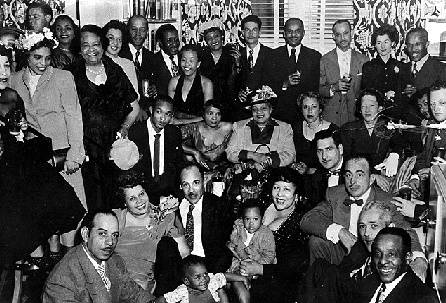Race Tolerance Part 2
Historical Essay
by Tommy Lott
Unidentified Family, 1960s
Photo: African American Historical and Cultural Society, San Francisco, CA
continued from previous screen
Although Johnson's interest in African art and the visual representation of African-Americans was shaped largely by his association with the Harlem Renaissance artists and the influence of Alain Locke, his distant location on the West coast has been an important factor in his construction as an African-American artist. Commentators rightly assume that there wasn't much of a black community in San Francisco, but they fail to consider the social significance of Johnson's mixed-race background in this context. With Johnson's African-American identity in mind they often conclude that he was "isolated." If this claim is taken to mean either that he was not a part of the art scene (centered on the East coast), or that he was not connected with the black community, it is very misleading. Johnson participated in all ten of the Harmon Foundation exhibitions of Negro art, as well as in an equal number of local and national exhibitions. In newspaper articles from the 30s and 40s, either his identity as an African-American artist was taken for granted because of the racial content of his art, or ignored as irrelevant. To use Dick Hebdige's phrase, Johnson seems to have been hiding in the light (Hebdige 1988). Knute Stiles points this out in his review of the Oakland Museum's retrospective of Johnson's work. Stiles claimed to have known Johnson for several years before he mentioned that he was a Negro; I hadn't noticed. I was to learn that he had publicized his blackness during the political thirties and always acknowledged his dedication to raising his black brothers out of poverty and misery (Stiles 1971). Unlike some of his family members who preferred not to identify themselves, or live, as African-Americans, Johnson chose not to pass, although he apparently was not opposed to capitalizing on his status as ethnically indistinct. There were several reasons Johnson's career in San Francisco during the 30s and 40s was not hampered by his racial background, but a paramount factor was that, in many circumstances, he was not perceived to be a black person.
If we situate Johnson's art in the context of what bay area artists were doing, it clearly reflects a cultural pluralism that did not exist in other parts of the United States. It is in this sense that the myth is sustained by Johnson's success. But if we consider the fact that Johnson self-consciously avoided raising political issues in his work we come closer to understanding why the idea of racial tolerance in San Francisco is only a myth.
The ambivalence those of us who take ourselves to be progressive sometimes feel towards Johnson's art derives from his refusal to use his art to advocate social change. When we consider Johnson's relationship with the black community the question arises as to whether he trained any black artist to painting murals in black churches, or, as a WPA unit supervisor, whether he included any black artists in any of his projects. Virtually nothing has been written about his relations with other Third World artists in the bay area. When we celebrate Sargent Johnson as one of San Francisco's great artists we must not fail to consider his success in relation to the social environment from which he emerged including the community of black artists with whom he associated in San Francisco.
--by Tommy Lott, excerpted from "Black Consciousness in the Art of Sargent Johnson" in Reclaiming San Francisco: History, Politics, Culture, A City Lights Anthology, 1998

